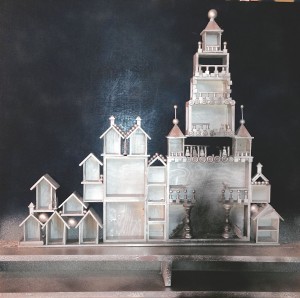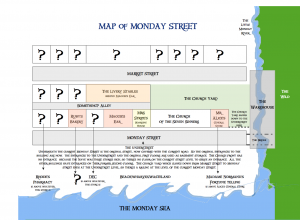Brainstorming Setting
Setting is more than location. It’s time, geography, weather, and people. It’s the wallpaper for your story, and just like wallpaper, poor choices and inadequate preparations can destroy the whole room story. We’re in the middle of brainstorming our setting–Toni and I at this point are obsessed–so I figured I’d give you an idea of how we’re doing it. Also, I don’t have time to write a blog post.
The working title for our book is Monday Street because that’s not just the location, that’s the state of mind. Monday Street is the bad part of the bad part of town, but it has its own laws (unwritten) and its own lawgivers (unelected), and it’s the wallpaper behind the actions of Cat, Mari, and Keely, our put-upon protagonists. That’s why I structured the collage around the street; the location in this book infused the entire story.
Monday Street is the former wealthy waterfront street of South Edge, across from the wharves of the Monday Sea. The main street of the Edge, aka the bad part of town, runs parallel to Monday Street, but once the streets hit South Edge, Monday Street is the power center. As we started brainstorming this, we knew that Cat lived in the belltower of the destroyed church and worked at Maggie’s Ear, Mari worked in the stables behind Maggie’s, and Keely lived in the Warehouse. That was pretty much it: four buildings. So when I started the collage which was for my stories–I don’t collage for the others because I can’t, their stories are theirs, I just leave room for their details in mine–I started with Maggie’s Ear and the church, and then built the rest of the street around them with the stuff I had on hand:
And then I though about what Monday Street meant to Cat, my character, and wrote this:
Monday Street is the main street of South Edge, so it’s a great place to get your pocket picked, wander down an alley and get mugged, or find a genuine fake relic that just fell off a truck. In the vernacular of New Riven, “He went down Monday Street” means roughly the same as “Here’s your Darwin award.” The architecture there is lovely because it was once the wealthiest part of town, beautiful townhouses across from a perfect beach, with a huge medieval church near the river. Then the Great War fought its last battle in South Edge and the magic fallout from the explosions made the entire borough uninhabitable. The two halves of the country agreed to part, using the Little Monday River as their border, and that split Riven City in half. The north half of the city became New Riven, a symbol of a bright new day, except for Forest’s Edge, now abandoned by the wealthy, soaked in magic, and the bolt hole for New Riven’s criminal population. So where Forest’s Edge was once the center of the city, now it’s the Edge, the last stop before the river and the desolation beyond that, the abandoned half of the city in Valden.
When the magic finally sunk to low enough levels that most of the Edge was clear, the city tried to reclaim it, but the criminal element had a firm grip on it and nobody with influence had any interest in rehabilitating the place (criminals don’t vote, and if they did, they’d vote against a rehab). In the interests of public health, the city focused on the last remaining magic toxin problem in New Riven, which was Monday Street. The lowest lying street in all of Riven, it still had magic at street level, so the city simply raised the road to the level of the second stories of the houses there, put in doors on the second level, and left the beach to rot. Smugglers put up makeshift wharves, and the white sand is long gone, but Monday Street thrives, and now enough time has passed that the original street level, now called the Understreet, is clear of toxins, too. The level below that, the basements and the crypt of the church, still have toxic pools, but nobody goes down there; the first floors of the buildings are the storage areas now, and everybody’s fine with that.
Monday Street, then, is where you’ll find the busiest criminal enterprises in the city, and the businesses that cater to them. Those include:
Rhodes Pharmacy, run by Martine Rhodes, a beautiful thirty-something known for her very fine eyes, her sexual appetites, and her ability to mix up damn near anything if you can pay her price. Favorite drink: absinthe with a dash of bitters.
Ruby’s Bakery, a bakery so good that people from the nice part of the city actually take their chances and send their servants there to buy bread. Ruby also operates a lunch counter inside the bakery, so that’s where Monday Street eats lunch. Ruby has strict rules like no magic inside the premises, but her Rumple is so good (a kind of stew inside one of Ruby’s amazing sour dough rounds) that people put up with the rules just to eat there. Plus if you break a rule, Ruby never lets you come back, and that’s unthinkable. Her granddaughter, Garnet works there, too.
The Department of Extraordinary Complaints: The only government office in South Riven, the DEC is where civil servants go to die. The head of the Dept is as yet unnamed, but his second-in-command is Moore, a doofus/genius who was demoted because of his many mistakes (but BRILLIANT insights) and who is now stuck running the Relics Room, the DEC’s evidence lock-up.
Maggie’s Ear: The hottest night spot in South Edge, probably because of the outdated gaslights, Maggie’s Ear is a bar and restaurant that opens at six PM and closes at six AM after serving breakfast. Jokes about Maggie being a vampire are made (she’s not), but not to Maggie’s face (she’s something else). She runs a very tight ship (Ruby copied her rules from Maggie’s) especially when it comes to her waitresses. Touch one of Maggie’s waitresses and you’ll never see the inside of the Ear again. She keeps a dormitory upstairs for any of the girls who want a free and safe place to sleep–not easy to find in South Edge–and an eye on everything that happens in her joint, especially if has to do with magic. Maggie has no time for magic. All of her waitresses are good, but three–Cat, Pansy, and Keely–are special. Moore from the DEC drops by to play piano most nights.
The Stables at the Ear: The stable’s behind Maggie’s Ear. Krissie will fill this in because that’s her Girl’s setting.
Mrs. Stripe’s Boarding House: Mrs. Stripe (not her real name, which is not unusual on Market Street) runs a boarding house, very respectable, two dollars a night for a room, paid in advance, please. All the rooms have striped wallpaper, hence her nickname. Harry’s living at Mrs. Stripe’s right now, and she thinks he’s a lovely boy. Quiet, though.
The Church of the Seven Sinners: Formerly the Church of the Seven Saints, this beautiful medieval house of worship had a hole blasted through the roof of its nave (not to mention the floor) when a magic orgy went wrong and exploded in its crypt. It’s theoretically condemned and deserted, but Cat’s living in the bell tower, and somebody’s digging in the crypt.
The Churchyard: Behind the Church and then running out to Monday Street farther down, the churchyard has beautiful grave markers and some small mausoleums. They’re still there because they’re too heavy to steal and impossible to hock. Nobody’s maintaining the churchyard now, so it’s overgrown, but it’s the closest thing Monday Street has to a park which means that at night, the grass moves. And sometimes moans. (That would be Monday Street lovers who have few inhibitions.)
The Monday Street General Store: Formerly the Church Parsonage, the General Store is run by Mr. Alice and has pretty much anything you want. (Mr. Alice bought the parsonage for a song when the magic finally settled down under the Understreet.) If it’s not in stock when you come in, Mr. Alice will have it for you by the next day, in most cases, practically new. Mr. Alice is cheerful and helpful and determined to make you buy something. Humor him.
Madame LeNormand’s Gipsy Fortune Telling: Madame LeNormand tells fortunes in Mr. Alice’s upstairs room (turn left at the housewares and keep going until you reach the weapons department. The stairs are behind the brass knuckles). There is speculation about how Madame pays her rent to Mr. Alice, but nobody would dream of actually asking.
The Warehouse: Once a convenient storage place for both sides of the city, the Warehouse sits high across the Little Monday River by the bridge into Valden. At least it used to. Over the years, the Warehouse has grown. It now covers the Bridge and is very slowly expanding down to the mouth of the bay. There is speculation about what will happen when it gets there. General consensus is that when it does, it’ll be a good time to be somewhere other than Monday Street. Oh, and it’s not abandoned: Keely lives there.
Here’s the working map, subject to a great deal of change:
You’ll notice there are question marks on the map. These are storefronts on the collage that haven’t been filled in, along with all of Market Street. We’re trying to brainstorm now what Monday Street residents might need–Mr. Alice sells groceries, too–that hasn’t been provided yet, on the theory that anything on Monday Street is there because the people of Monday Street want and need it. (Suggestions are welcome. The collage is here if you want another look.)
The map also helps keep us oriented. I was just talking with Toni about how Keely gets home from Maggie’s Ear when she gets off work. Toni said, “She goes down the Understreet to the Warehouse.” So I walked along with her in my mind, seeing what she’d see and realized that the church yard on the Monday Street side would slope down to Understreet Levels, so there must be a railing up on the current Monday Street. That means something to tip bodies over and something for Cat to climb, but also that there’s light in the Understreet there because it’s the one place that’ll be open to the sky. It’s the fictional equivalent of walking-the-terrain, and it opens up huge possibilities the same way the real walking-the-terrain does.
Between the map and the collage, I’m getting a grip on my setting which means I’ll be able to pretty much ignore it once I start writing in earnest. After all, it’s just story wallpaper.
But we think it’s great wallpaper.

 newest »
newest »
 This is great! It answers so many questions I've often wondered about writing. As a reader I often wonder how the author decides on a location, the atmosphere, the charachter names and their emotional makeup. Thanks for sharing this on Goodreads. I often forget to check out your blog.
This is great! It answers so many questions I've often wondered about writing. As a reader I often wonder how the author decides on a location, the atmosphere, the charachter names and their emotional makeup. Thanks for sharing this on Goodreads. I often forget to check out your blog.





